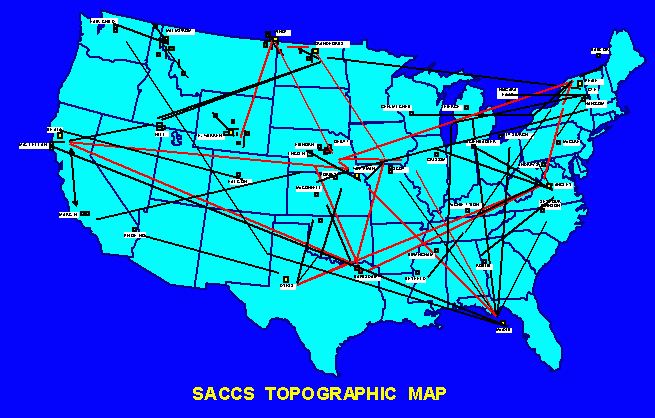



Strategic Automated Command Control System
The Strategic Automated Command Control System [SACCS] network is the primary network for the transmission of Emergency Action Messages (EAMs) to the warfighting commanders in the field. It is the prime communications link between the CINC USSTRATCOM and their nuclear missile forces, as well as to other offensive and defensive forces world-wide. The system provides critical secure (TS) command control information, such as EAMs, FDMs, situation monitoring, current intelligence, force status, operations monitoring, warnings, strategic replanning and redirection, and damage/strike assessments. The system also provides SIOP (TS-ESI) messages to HQ ACC, AMC, AFRC and ANG for their deployment. SACCS is located in the CINCSTRAT command post, strategic
command centers, missile launch control centers, launch control facilities, and at strategic aircraft sites. The system was initially fielded in 1963 and was updated by SACDIN in 1988.
The SACCS Data Transmission Subsystem provides primary command and control capability for receiving and transmitting secure EAMs, Force Direction Messages, and various informational type messages from the NCA to and from the CINC United States Strategic Command, and to the strategic nuclear missile and bomber forces. SACCS also provides SIOP messages to Air Combat Command, Air Mobility Command, and the Air National Guard and Air Force Reserve for their effective deployment of strategic bombers, reconnaissance aircraft, mobilization aircraft, and tanker support aircraft worldwide.
SACCS is operationally capable of providing full-duplex, secure data communications over any level of projected message
activity.
The network currently has 93 active nodes located across the
country with 20 additional Air National Guard sites slated to
come on line sometime in the next year. The network is
composed of a hierarchical series of processors consisting of
two Subnet Communications Processor (SCP), eight Base
Communications Processors (BCP), numerous Hardened User
Terminals (HUTE) and Collocated user terminals (CUTE), and
the associated lines linking the processors together.
The SACCS network also serves six external interfaces: Data Processing Subsystem (DPS), Air Force Global Weather
Center (AFGWC), Command Center Processing and Display System (CCPDS), AUTODIN, Air Force Satellite
Communication (AFSATCOM), and 616A ( a survivable Low Frequency Communications System).
In 1956 Gen. Curtis LeMay, commander-in-chief of SAC, saw a need for improving SAC's command and control system. A coordinated effort was undertaken by government and industry to provide this system. The project was designated 465L, and was the predecessor to the current Strategic Automated Command Control System network. In the mid 1960's, SAC procured the 465L system, which was designed to be survivable and to provide rapid transmission, processing, and display of information to support command and control of SAC's geographically separated forces.
By the mid 1970's, SAC began a program to replace the aging hardware of the SACCS network and provide improved capabilities. The new system, the SAC Digital Network, was a subsystem of the Worldwide Military Command and Control System. It provided secure two-way communications between the National Command Authority, CINCSAC, SAC aircraft bases, and missile combat crews during peacetime and trans- and post-attack periods. Special emphasis was placed on SACDIN's ability to maintain an end-to-end message delivery time of not more than 15 seconds for Emergency Action Messages. Total system cost for SACDIN, including a later modification, was nearly $1 billion. After formal acceptance, the system became known as SACCS.

Click here for expandable PPT version
Sources and Resources
http://www.fas.org/nuke/guide/usa/c3i/saccs.htm
Maintained by Webmaster
Updated Sunday, January 10, 1999 5:53:26 PM







